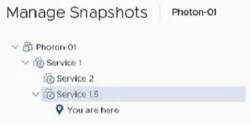An administrator needs to upgrade the guest operating system installed in a virtual
machine. The administrator wants to safely ensure that the selected operating system is
supported by ESXi. Which action should the administrator take to meet this goal?
A.
Perform a guest OS and product search In the VMware Compatibility Guide.
B.
Look in the guest OS version drop-down menu of the VM.
C.
Snapshot the VM before performing the operating system upgrade.
D.
Check the web page of the guest operating system vendor.
Snapshot the VM before performing the operating system upgrade.
Which DRS score indicates that the virtual machine (VM) is experiencing severe resource
contention?
A.
50%
B.
95%
C.
70%
D.
15%
15%
Which event type indicates a Fatal problem has occurred in the system, and the process or
operation will be terminated?
A.
Information
B.
Audit
C.
Error
D.
Warning
Warning
A vSphere administrator wants to monitor the CPU usage of all virtual machines (VMs) in a
specific host cluster using alarms. Which sequence of actions should the administrator
use?
A.
Click on the ESXI host and add an alarm.
B.
Click on the cluster and add an alarm.
C.
Click on individual VMs and add an alarm.
D.
Click on the VMs folder and add an alarm.
Click on the cluster and add an alarm.
Which problem is solved by migrating virtual machines (VMs) using vSphere vMotion?
A.
A vSphere cluster that needs to be upgraded without any VM downtime.
B.
A problem that occurred during VM patching and a roll-back is needed.
C.
The names of the VM files that do not match the inventory name of the VM.
D.
Heavy storage traffic and latency that are concentrated in a few datastores.
Heavy storage traffic and latency that are concentrated in a few datastores.
Which feature helps maintain zero data loss when a VM on an ESXi server fails
unexpectedly?
A.
vMotion
B.
Fault Tolerance
C.
Storage vMotion
D.
vSphere High Availability
vSphere High Availability
Which software-defined, object-based storage solution provides shared storage for
vSphere clusters without using traditional external storage?
A.
ISCSI
B.
vSAN
C.
NFS
D.
vVOLS
ISCSI
A vSphere administrator sees the alarm:
vSphere HA virtual machine failed to failover
This occurred for virtual machines (VMs) in a cluster with vSphere High Availability (HA)
enabled. The guest operating system on the VMs did not report a power failure.
What is a possible cause of this event?
A.
The host is still running but has disconnected from the network.
B.
The VMs cloning operations did not complete.
C.
A reboot of vCenter Server impacted vSphere HA.
D.
The VMs encountered an error during migration using vSphere vMotion
The host is still running but has disconnected from the network.
A system administrator opened a technical support trouble ticket and was asked to provide
the suspended virtual machine's memory contents.
Which file from the virtual machine directory will the system administrator need to upload to
technical support?
A.
vm.vmdk
B.
vm.vmss
C.
vm.vmx
D.
vm.log
vm.vmx
An administrator would like to add a new server into an existing vSphere cluster. The
servers are running Intel processors. The administrator needs to ensure that the new
server can be added to the cluster with the same processor baseline as the existing
servers. Which strategy should be used to achieve this goal?
A.
Fault Tolerance
B.
Enhanced vMotion Compatibility
C.
vSphere vMotion
D.
vSphere High Availability
Enhanced vMotion Compatibility
A vSphere operator finds this error message:
Device or filesystem with identifier [naa.6000eb31dffdc33a000000000000002a] has
entered the All Paths Down state.
What should the operator conclude from this error message?
A.
A host Is Inaccessible, and migration of affected VMs is expected.
B.
A host failed, and automated recovery of affected VMs Is expected.
C.
A storage device has failed and is not expected to become available.
D.
A storage device is inaccessible and is expected to become available.
A storage device has failed and is not expected to become available.
Refer to the exhibit:
An administrator deletes the Service 1.5 snapshot.
What is the result of this action?
A.
Reversion to Service 1 snapshot, and Service 2 snapshot will remain.
B.
Reversion to Service 1 snapshot, and Service 2 snapshot will be deleted.
C.
Reversion to Service 2 snapshot, and Service 1 snapshot will be deleted.
D.
Deletion of all snapshots.
Reversion to Service 1 snapshot, and Service 2 snapshot will remain.
| Page 1 out of 5 Pages |